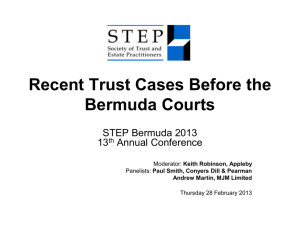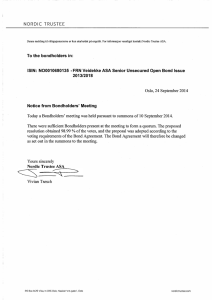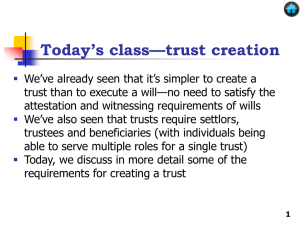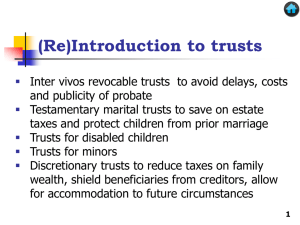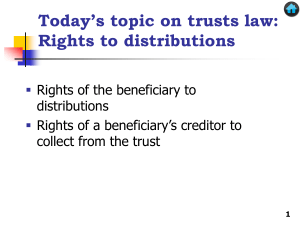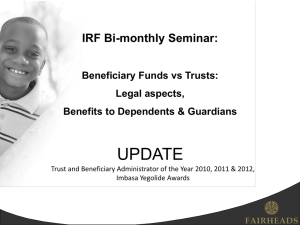2013 Probate and Trust Legislation Affecting Corporate Fiduciaries
advertisement
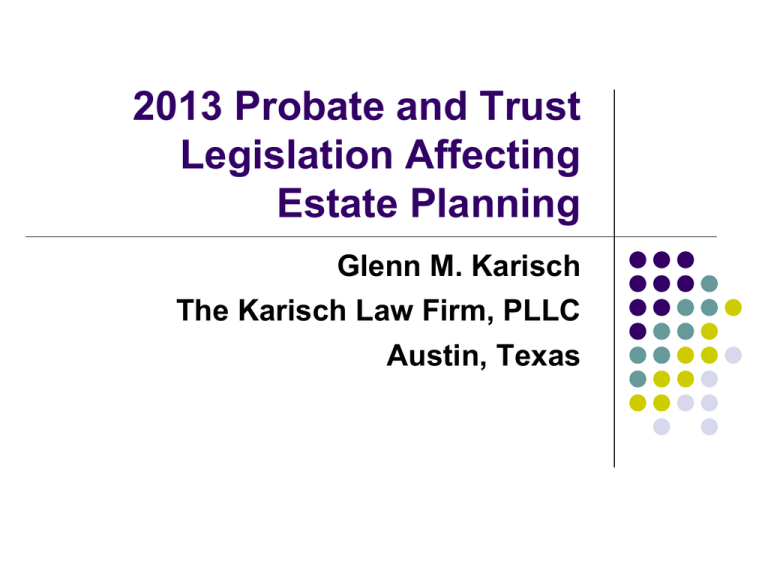
2013 Probate and Trust Legislation Affecting Estate Planning Glenn M. Karisch The Karisch Law Firm, PLLC Austin, Texas The big picture Hitting the high points, with an emphasis on changes affecting estate planners and their tools Bill Pargaman’s paper Glenn’s paper www.texasprobate.com The Texas Probate Mailing List The new Estates Code Becomes effective January 1, 2014 The Probate Code is repealed Estate and guardianship administrations pending on January 1, 2014, become subject to the new code References in various statutes to Probate Code sections are considered to be references to the appropriate Estates Code sections But what about references in documents? The new Estates Code A “non-substantive” codification, but: There will be confusion over section numbers There is some new terminology Other legislation makes substantive changes to the new Estates Code The new Estates Code New structure – like other codes Chapters 31 – 551: decedents’ estates Chapters 751 – 752: powers of attorney Chapters 1001 – 1253: guardianships Chapters 1301 – 1302: management trusts, pooled trust subaccounts The new Estates Code New terminology “Appertaining or incident to estate” vs. “probate proceeding” and “matter related to probate proceeding” “Dependent administration” vs. “personal representative subject to court supervision” “867 trusts” now “1301 trusts” (or just “management trusts”)? “128A notices” now “308.002 notices”? “294(d) notices” now “308.054 notices”? Decanting (later) New statutory durable power of attorney form Disclosure statements to principal and agent Initialing, not crossing out (N) – all of the above Not a general power of appointment New form becomes effective January 1, 2014 Form is not mandatory and may be modified Two suggested modifications: If (N) is selected, it is a general POA Construe it as a statutory durable POA New forms available at texasprobate.com New medical POA form and disclosure statement Incorporates prior change permitting medical POAs to be notarized, not witnessed The form changes The disclosure statement changes Disclosure statement must be substantially in the statutory form New forms become effective January 1, 2014 New forms available at texasprobate.com Will and trust forfeiture provisions The party seeking to avoid forfeiture has the burden to prove just cause and good faith by a preponderance of the evidence Legislative history: The bill does not repeal Texas law recognizing that forfeiture clauses generally will not be construed to prevent a beneficiary from seeking to compel a fiduciary to perform his duties, seek redress from breach of fiduciary duties or to seek a judicial construction of a will or trust Non-testamentary transfers The McKeehan case Texas residents Michigan financial institution Michigan choice of law provision in the account agreement Account agreement does not meet Texas requirements for right of survivorship Held: Michigan law applies, so account passes by right of survivorship Non-testamentary transfers New statute If more than 50% of the property in the account belongs to Texas residents, Texas law applies notwithstanding a choice of law provision inserted by the financial institution The new statute also applies to IRA benefits and similar arrangements The choice of law provision still applies to issues between the customer and the financial institution Disclaimers: trap for the unwary Disclaimer is not effective if the beneficiary owes certain child support arrearages Every disclaimer must include a statement regarding whether the beneficiary is a child support obligor as defined by the statute Include this language in every disclaimer (assuming it is true): “Disclaimant is not a child support obligor described by Tex. Est. Code § 122.107.” Failure to do so may keep the disclaimer from being a qualified disclaimer Becomes effective January 1, 2014 Decedents’ estates changes Affidavit in Lieu of Inventory Affidavit available even if will “requires” inventory No “rock-and-a-hard-place” decision Remedies for incorrect affidavit Suggested will language: “return of any required inventory” “return of an inventory or an affidavit in lieu of the inventory” Decedents’ estates changes Heirship Changes No statute of limitations Any creditor can initiate proceeding Ad litems Required for heirs whose names or whereabouts are unknown Permitted for incapacitated heir if “necessary to protect the interest of the heir” Parent may waive citation for child under 12 No final order until affidavit or certificate of notice filed Testimony reduced to writing Decedents’ estates changes Addresses not required in application for administration/letters testamentary No unsworn declarations for self-proving affidavits, but they are permitted in other cases, such as for the report of a guardian of the person Foreign self-proving affidavits $1,000 fine for failure to timely file inventory and continued failure after notice and hearing Inventory of Successor Representative If DOD inventory has been filed, successor’s inventory is as of qualification Decedents’ estates changes Exempt Property If the Decedent is survived by a spouse or minor child, the homestead is exempt from all creditors other than mortgage debt and taxes – adult unmarried children are out Occupancy does not matter Query: does this work if the homestead is in a trust? Insurance proceeds paid to an estate as any kind of beneficiary (not just contingent beneficiary) is exempt Roth IRAs and inherited Roth IRAs are exempt Increased allowances in lieu of homestead ($15,000 to $45,000) and other exempt property ($5,000 to $30,000) Trust Code changes Spendthrift protection is not lost if a settlor becomes a beneficiary by the exercise of a power of appointment Example: Husband creates inter vivos QTIP for wife and gives wife special power of appointment Wife exercises the power of appointment in trust for husband after her death Husband enjoys spendthrift protection after wife’s death Trust Code changes TTC §112.035(d)(2): Spendthrift protection is not lost solely because the settlor’s interest was created by the exercise of a POA TTC §112.035(g): Safe harbor – property will not be considered to have been contributed by the settlor in the specific laundry-list of cases The TBA Trust Code changes A corporate trustee may purchase insurance underwritten or distributed by an affiliate, subject to its fiduciary duties, unless the trust instrument prohibits it Instead of paying trustee compensation onehalf from principal and one-half from income, the trustee may, consistent with its fiduciary duties, allocate compensation differently Decanting What is decanting? Who thinks up these names? Restatement (3rd) Third of Property: Wills and Donative Transfers, §17.1 distinguishes decanting and powers of appointment A power of appointment may be exercised in nonfiduciary capacity, is personal to the powerholder and lapses when the holder dies A “fiduciary distributive power” must be exercised in a fiduciary capacity, succeeds to a successor trustee (trust protector?) and survives the death of the trustee Decanting The new Texas statute calls it “Distribution of Trust Principal in Further Trust” New Sections 112.071 – 112.088 of the Trust Code Shannon Guthrie’s paper: Decanting with Benefits Decanting Prior law No “default” statutory provision, but the settlor could provide for decanting in the trust instrument New law: Settlor still may expressly provide for decanting Settlor may expressly prohibit decanting If the trust instrument is silent, the new decanting statute applies Decanting Why decant? Shannon Guthrie’s list: Correct a drafting mistake Clarify ambiguities in the trust agreement Correct trust provisions due to mistake of law or fact to conform to the grantor’s intent Update trust provisions to include changes in the law, including new trustee powers Change situs of trust administration for administrative provisions or tax savings Combine trusts for efficiency Decanting Why decant? Shannon Guthrie’s list: Allow for appointment or removal of trustee without court approval Allow appointment of special trustee for limited time or limited purpose Change trustee powers, such as investment options Transfer assets to a special needs trust Add a spendthrift provision Divide pot trust into separate share trusts Decanting Why decant? Shannon Guthrie’s list: Adapt to changed circumstances of beneficiary, such as substance abuse, creditor or marital issues, including modifying distribution provisions to delay distribution of trust assets Partition for marital deduction or GST planning Avoid the rule against perpetuities? Express vs. statutory decanting power – the rest of the discussion will focus on the statutory decanting power Decanting “Full discretion” trusts – the trustee’s power to distribute is not limited in any manner Trustee may distribute principal to another trust for the benefit of one or more of the current beneficiaries of the first trust Trustee may give a wholly discretionary beneficiary a broad power of appointment If there are multiple trustees and fewer than all have full discretion, the “full discretion” trustees may exercise this power without the participation of any “limited” trustees Decanting “Limited discretion” trusts – the power to distribute is limited (HEMS trusts are limited) Trustee may distribute principal to another trust so long as: the current beneficiaries of both trusts are the same; the successor and remainder beneficiaries of both trusts are the same; and The distribution language of both trusts is the same Thus, it is useful only for administrative changes Decanting Trustee must act in good faith, in accordance with the terms and purposes of the trust and in the interests of the beneficiaries In no case is the trustee deemed to have a duty to decant The power to decant is reduced to the extent it would cause any intended tax benefits to be lost Decanting The trustee may not: Take away a beneficiary’s mandatory distribution right Materially impair the rights of any beneficiary Materially lessen the trustee’s fiduciary duty Decrease the trustee’s liability or exonerate the trustee Eliminate another person’s power to remove the trustee Modify the perpetuities period, “unless expressly permitted by the terms of the first trust” Decanting The trustee must give at least 30 days’ notice to current beneficiaries and presumptive remainder beneficiaries (including the AG, if a charity is a beneficiary) If no one objects, the trustee may decant without judicial approval, although the trustee may seek judicial approval if desired If a beneficiary other than the AG objects, the trustee may seek judicial approval but is not required to do so If the AG objects, the trustee must seek judicial approval Decanting The trustee may not decant without judicial approval solely to change the trustee compensation provisions The trustee may change compensation provisions if the change is in conjunction with other changes for which there are valid reasons, so long as the change does not provide for unreasonable compensation under Texas law Decanting “The legislature intends [the decanting provisions] to be a codification of the common law of this state in effect before the effective date of this Act” Except as otherwise provided by the trust instrument, the decanting provisions apply to trusts existing or created on or after September 1, 2013 Decanting Decanting drafting suggestions Include an express decanting power where appropriate Have a plan for having an independent trustee or trust protector do or direct the decanting Specifically authorize decanting to a trust: Subject to the laws of another state With one, some or all of the same beneficiaries – beneficiaries need not be identical – and excluding one or more beneficiaries Expressly permit modification of the perpetuities period Permits the addition of more remote descendants and persons appointed by a beneficiary holding a power of appointment as beneficiaries Decanting Suggestions about implementing decanting If you decant to a trust subject to another state’s laws, make sure there is a reasonable nexus to the state Query: Would a Texas two-step work with a HEMS trust? Step one: Decant a Texas HEMS trust “Trust 1”) to a trust (“Trust 2”) subject to the laws of a state which permits broader decanting Trust 2 must meet Texas standard for limited discretion trusts Step two: The trustee of Trust 2 later decants to a trust (Trust 3) with different beneficiaries, or with one or some but not all of the same beneficiaries, etc. The trustee of Trust 1 may breach his duties if it is a prearranged plan
